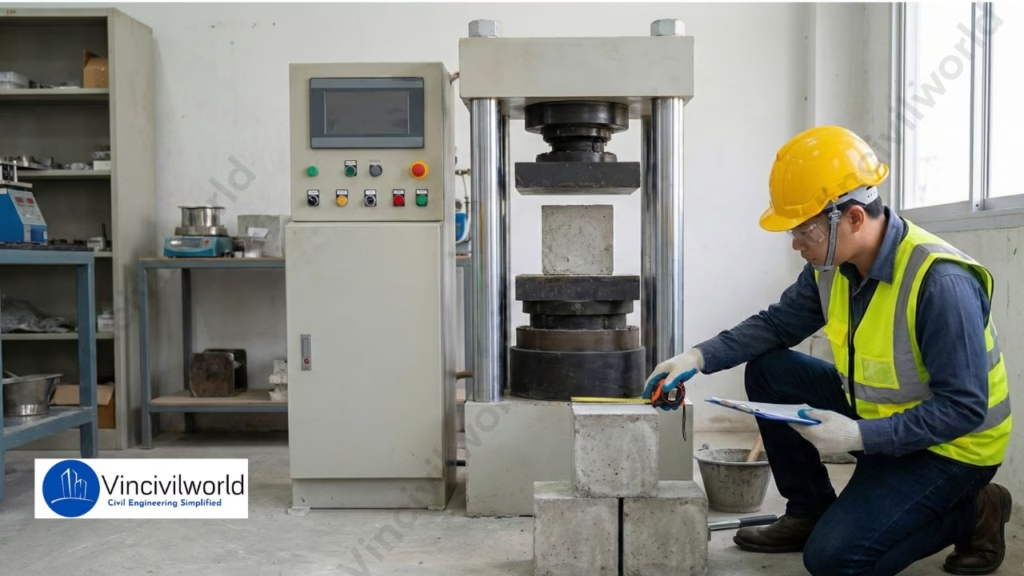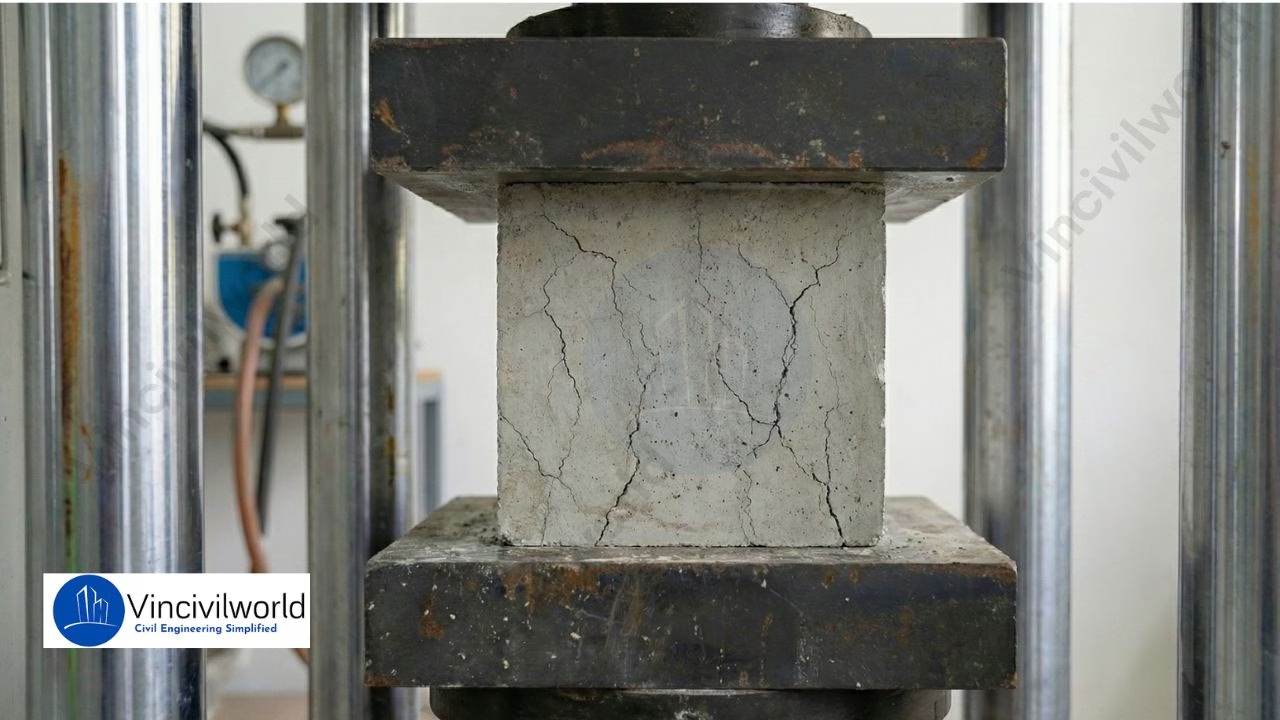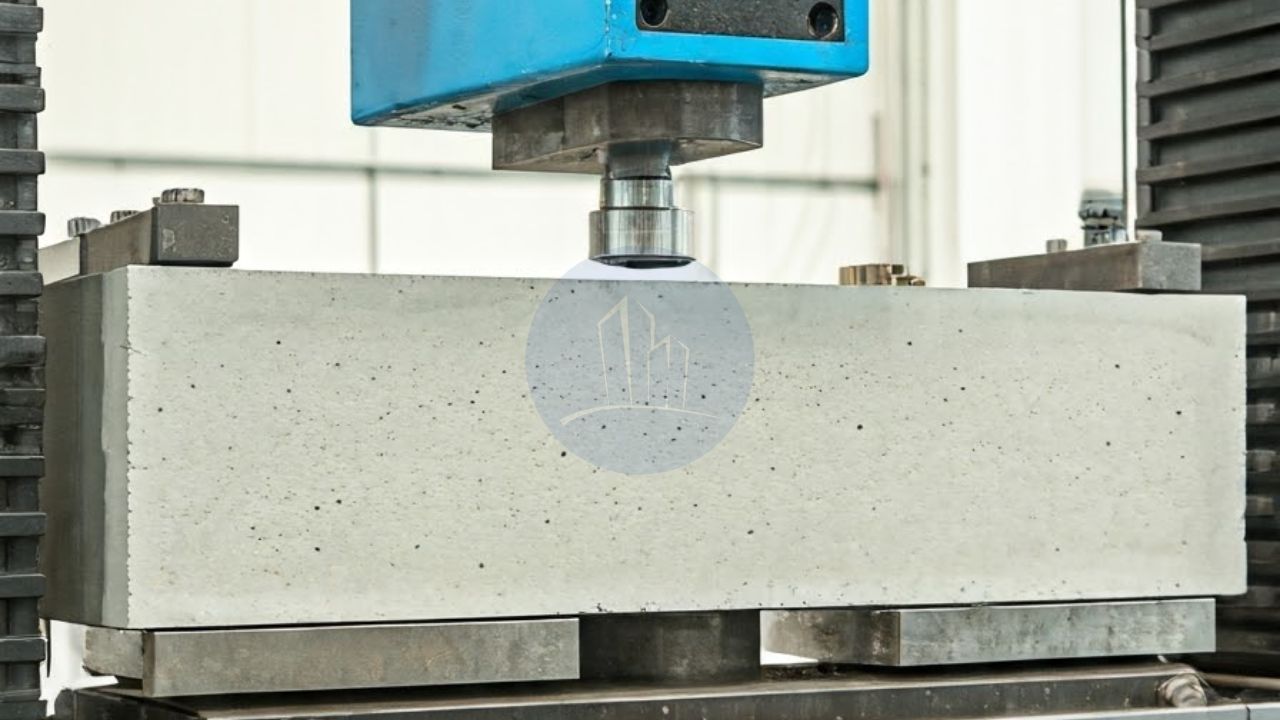Compressive strength test of concrete is the most important method used to evaluate the load-carrying capacity and overall quality of hardened concrete. The compressive strength of concrete directly influences the safety, durability, and performance of any structure. Engineers commonly determine this property using the concrete cube compressive strength test or cylinder testing, depending on applicable standards. The concrete compressive strength test procedure involves applying a gradually increasing load until failure occurs, allowing accurate assessment of material behavior under compression. Results from the compressive strength test of concrete cube and cylinder help verify mix design suitability, workmanship quality, and compliance with specifications. This test plays a critical role in quality control, structural design validation, and ensuring reliable performance of concrete in construction projects.
Table of contents
Significance of Compressive strength test of concrete
Compressive strength of concrete is the ability of the concrete to withstand loads without cracking or deformation. Compressive Strength of concrete is defined as the Characteristic strength of 150 mm size concrete cubes @28 days. Marginal variations in water to cement ratio, ingredient proportioning, increase in a slump, etc impacts the desired concrete strength which in turn affects the strength and stability of structures.
Several tests are used to determine the strength of concrete at different stages. Quality tests on concrete must be conducted from the production stage to the hardened stage and even on completed structures. These tests play a crucial role in ensuring construction quality and structural reliability. This article focuses on the splitting tensile strength test of concrete to evaluate and derive the tensile strength of hardened concrete in a reliable and standardized manner.
Quality tests on concrete
The Quality tests are done on different stages like production stage, hardened stage and Non destructive tests.

- Production stage quality tests ( On fresh concrete before placing)
- Hardened stage quality tests ( hardened concrete specimens)
- On structures (tests done on the structures)
Quality tests on Fresh concrete
Quality tests on hardened concrete
- Compressive strength
- Tensile strength – Split tensile strength
- Flexural strength test
- Water absorption test
Non destructive tests on concrete
- Rebound hammer
- Penetration resistance test
- Ultrasonic pulse velocity test
This article is about compressive strength test of concrete, its significance and procedure.
Compressive strength test of concrete cube/cylinder – Definition
As a primary construction material, concrete must be capable of withstanding heavy compressive loads. Concrete resists the applied compressive load by reducing in size, and this resistance defines its strength. Concrete gains strength gradually over time through hydration. The compressive strength of concrete depends on factors such as cement strength, water–cement ratio, mix quality, and curing conditions. The compressive strength test of concrete provides a clear understanding of these parameters and the overall quality of the concrete produced. By conducting this test, engineers can accurately assess concrete performance and suitability for structural use. The compressive strength is calculated from the failure load applied during testing and the cross-sectional area of the concrete specimen.

Concrete used for general construction typically achieves compressive strengths between 15 MPa and 30 MPa, while commercial, industrial, and special structures require higher strengths based on design and loading conditions. Engineers use the compressive strength of concrete as a key parameter to assess structural performance and durability.
The compressive strength test of concrete helps in determining the following:
- Quality control of concrete production and workmanship
- Acceptance or rejection of concrete as per specifications
- Effectiveness of curing and curing methods
- In-place concrete strength for structural assessment
- Age and strength development of concrete
- Compliance with design mix requirements
- Overall structural safety and reliability
This test plays a vital role in ensuring consistent concrete quality and long-term performance in construction projects.
Formula for compressive strength
Engineers calculate compressive strength by dividing the load applied at the point of failure by the cross-sectional area of the concrete specimen face (cube or cylinder) on which the load acts.
Compressive Strength = Load / Cross-sectional Area
Relevant standards and codes
- Indian Code (IS 516) – Specifies methods for determining compressive strength of concrete
- American Code (ASTM C39) – Standard test method for compressive strength of concrete cylinders
- European Code (BS EN 12390-3) – Describes testing of hardened concrete for compressive strength
The test procedures are fundamentally similar across IS, ASTM, and EN codes, with minor differences in specimen size, loading rate, and reporting format.
Apparatus used for compressive strength test
- Compression testing machine
- Concrete cube or cylindrical specimen
- Moulds for specimen preparation
- Tamping rod
- Weighing balance

Compressive strength test of concrete – Specimen sizes
The specimen for this test can be cubic or cylindrical. The dimension of the specimens is as follows.
- Cube = 150mm x 150mm x 150mm
- Cylinder = 150mm diameter, 300mm height
The mould is made up of cast iron or steel. Cubical moulds are preferred for most works.
Concrete cube compressive strength test procedure
The concrete cube compressive strength test procedure is as follows
Mixing of materials.
- The first step is to prepare the test specimen by mixing the ingredients.
- Mix cement, fine aggregate, and coarse aggregate uniformly in dry condition.
- Add the required quantity of water gradually and mix thoroughly.
- Mixing of materials can be done using a batch mixer or by hand mixing.
- Ensure all ingredients are brought to room temperature before commencing the test.
- The concrete mix should be uniform in color and consistency.
Preparation of Test specimen
- Clean the cube mould thoroughly and apply lubricant on the inner surfaces.
- Prepare at least three specimens from each batch of concrete.
- Fill the mould with concrete in three equal layers of approximately 50 mm thickness.
- Compact each layer by giving 35 strokes using a tamping rod or by vibration.
- Ensure proper compaction to remove air voids.
- Remove excess concrete using a trowel and finish the top surface smoothly.
- Mark the specimen with date, grade of concrete, and identification details.
- Store the filled moulds at a temperature of 27 ± 2 °C for 24 hours.
Procedure for testing
- After 24 hours, remove the specimens from the moulds.
- Immerse the specimens in clean water for curing until the time of testing.
- Test the specimens at 3, 7, and 28 days using a compression testing machine.
- Before testing, remove the specimen from water and wipe off surface moisture.
- Measure and record the dimensions and weight of the specimen.
- Place the specimen centrally on the compression testing machine platen.
- Apply load gradually and uniformly at a rate of 140 kg/cm² per minute without shock.
- Record the maximum load at which the specimen fails.

Calculation of compressive strength of concrete cube/cylinder
The compressive strength of the concrete = Load at which the concrete breaks / Cross-sectional area of the specimen.
The compressive strength is expressed in N/mm2. The cube specimen is tested at 7, 14 & 28 days.
Engineers calculate the compressive strength of concrete using the failure load and the cross-sectional area of the specimen.
Compressive strength (fₐ) = P / A
Where:
P = maximum load at failure
A = cross-sectional area of specimen
The unit of compressive strength is N/mm² (MPa).
Key Takeaways
- The compressive strength test of concrete evaluates load-carrying capacity and overall quality, influencing structural safety and performance.
- Engineers assess compressive strength using cube or cylinder tests, applying increasing loads until failure occurs.
- Quality tests on concrete occur at different stages: production, hardened stage, and non-destructive tests to ensure reliability.
- The test outcomes support quality control, compliance with specifications, and verification of mix design suitability.
- Compressive strength is crucial for assessing structural durability, with typical values ranging from 15 MPa to 30 MPa.
Conclusion
The compressive strength test of concrete is the most important method for evaluating the strength and performance of hardened concrete. Since the compressive strength of concrete governs the safety, durability, and load-carrying capacity of structures, this test is essential in quality control and structural assessment. Engineers widely use the concrete cube compressive strength test and the compressive strength test on concrete cylinders to verify mix design suitability and workmanship quality. By following the standard concrete compressive strength test procedure, engineers can accurately determine whether concrete meets design and specification requirements. Results from the compressive strength test concrete cube help assess curing effectiveness, acceptance of concrete, and in-place strength. Overall, this test ensures consistent concrete quality, reliable structural performance, and long-term safety in construction projects.




One thought on “Compressive strength test of concrete | Cube test for Concrete”
Comments are closed.